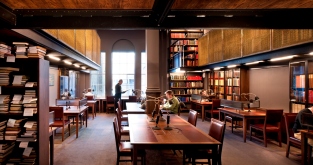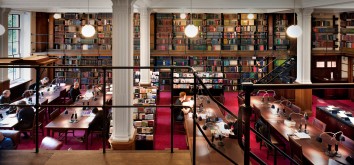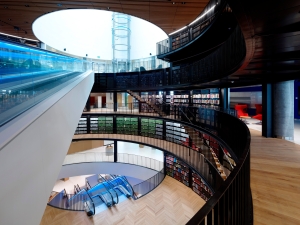Oxford Dictionary of Journalism
Tony Harcup.
(Oxford University Press, 2014
The only problem about the late Nick Tomalin’s 1969 assertion that rat-like cunning was one of only three qualities requisite of a good journalist – the others were a plausible manner and a little literary ability – is that it’s pretty damaging to the reputation and standing of the average rat. The RSPCA will probably mount a campaign. Rats get a bad press – ask James Cagney, who in any case was misquoted – though enquiring minds might wonder what’s so particularly cunning about the little blighters, anyway.
Tomalin’s job description appears, under R, in the Oxford Dictionary of Journalism. The rat-like cunning quote, it says, is “particularly beloved of old-school journalists who dismiss the value of journalism education and reject the idea that journalistic skills can be taught.” The notion of hackademics (qv) is seldom absent for long from Tony Harcup’s timely addition to the Oxford’s ostrich-egg oeuvre. He is, after all, a senior lecturer in journalism.
So, hot metal staples like death knock, doorstepping and, yes, Street of Shame, sit a little uncomfortably alongside latter-day concepts like technological determinism, cultural imperialism and reflective practice – all of which, apparently, are now taught to aspiring journalists. It’s unclear if they’re taught how to write and, if they are, how high the success rate is…
Harcup manifestly knows his subject. If not quite allowed by his editors to express an opinion – inconceivable in more traditional dictionaries – then frequently he hints at one. The style’s effective.
Those of us from the Dotheboys Hall school of journalism, raggy trousered practitioners from a two-up, two-down in the Street of Shame – and with an outside netty down the yard – might find his road map of a rapidly changing world especially useful. Churnalism, we learn, is the practice in battery hen newsrooms of simply recycling what arrives electronically at one end and is sexlessly re-laid at the other. Bigfooting is what happens when a star name is allowed out to cover a major story on another guy’s territory. Astroturfing – nice one this – is the false representation of grass roots support for a campaign or idea.
The dictionary also notes that the cuttings library was known as “the morgue”. Such places now rest, their sepulchred treasures seldom disturbed by the technologically literate.
Among all the reflective imperialism (or whatever) it’s comforting also to find room for the much-traduced apostrophe – and here he clearly speaks from exasperated experience. “An important punctuation mark, the misuse of which is common among those training to be journalists.”
Wisely, incidentally, none of the big footers is identified. It is a dictionary of terms, not of individuals. No names, no rat pack drill.
Unlike other Oxford dictionaries, the paperback may not be a doorstop but it is certainly a mile post. Journalism has travelled far since Nick Tomalin’s observations in the Sunday Times. Whether it has changed for the better must be left to those adept at reading between the lines. Tomalin was killed in 1973, while covering the Arab-Israeli war.
(Mike Amos MBE, The Northern Echo)
Mike Amos started his journalistic career on the Northern Despatch before moving to, and staying with, The Northern Echo until his recent retirement. He was awarded an MBE in 2007 for his services to journalism in the North East. Mike continues to write for The Northern Echo in a freelance capacity.
Search: Theory and practice in journalism online
Murray Dick
Palgrave Macmillan, 2013
9780230301894
Dick Murray’s book explores the theory and ethics of searching while also including practical guidance on using different tools and approaches for the twenty-first century journalist. The text is ideal reference material for students and journalists.
Journalism in the digital age is explored against the topical issue of ethics. Information overload is also identified as a key challenge facing journalists today and other problems include lack of time and as a result reliance on popular search engines such as Google which raises concerns over personalised results, censorship and commercial interests.
The first chapter provides an introduction to searching theory with practical tips that are ideal for students. In the second chapter Murray includes real life examples when discussing metasearch engines and semantic, virtual, social and mobile searches. Readers can keep updated on developments through a list of websites, including Phil Bradley’s Weblog. The invisible web, the material that a general search is unable to retrieve, is the focus of the third chapter and contains advice on how to use subject directory portals, directories, industry vortals and gateway services where specialists can help with research.
Murray charts the effect of social media upon journalists’ relationships with sources. Chapter four cites social online tools that offer a means for sourcing opinion, expertise and first-hand experiences while also considering the issue of privacy. The theme is continued in the following chapter which explains how journalists can use social networks, including Facebook and Twitter, to make contacts and source news.
Chapter six provides practical tips on finding and using multimedia, while also examining the legal and ethical aspects, including intellectual property rights and contempt laws. The seventh chapter discusses the ‘beat’, the routine the journalist follows each day making contact with organisations in search of news. He explores ‘verticals’ including Google News, Digg and reddit. Verifying online sources and advice on how a journalist can identify a hoax, concludes the book. Search: Theory and practice in journalism online is a comprehensive reference source that is ideal for journalism students and experienced journalists who wish to develop their digital skills. (Lynsey Blandford, LSE)
The 21st century journalism handbook: essential skills for the modern journalist
Tim Holmes, Sara Hadwin and Glyn Mottershed
Pearson, 2013
9781405846325
The 21st century journalism handbook is primarily an introduction for students training in newspapers, magazine and online reporting. It has a colourful and magazine-styled layout that creates an engaging and modular textbook. The work covers the core principles and practices for today’s journalist and incorporates theory with case studies and practical exercises to help readers learn and develop skills. It is written by experienced journalists and teachers of journalism which is evident through the style of the textbook. There are key points summarised at the end of each chapter and a companion media and journalism website with links and resources. The structure of the book is suited to students dipping into sections to quickly retrieve facts.
The book begins with an exploration of the development of print media, including an overview of legal frameworks and current challenges. Research skills, interview techniques and an introduction to social media and data journalism form the second chapter. The writers offer practical and personal advice by sharing experiences of disastrous interviews. The section on news writing, which opens with a case study of a high profile murder, guides the student through the methods of writing a clear story. Feature writing is also explored in terms of how to find ideas, research and develop them into an engaging piece.
The writers widen their perspective and explain the processes involved in organising production on a modern publication. They identify important skills for the future, including web management, and video, audio and social media skills. The role of the sub-editor and the different demands of print and online offer an interesting insight into another role within the profession. Specialist journalists in diverse fields ranging from business to the arts are also covered. The subject of convergence, the coming together of different media platforms, is examined in terms of how the journalist must now use traditional print skills and be prepared to experiment with new technology. The textbook also provides useful bite-sized guidance on law, regulation and ethics, in particular Freedom of Expression and the Human Rights Act. The final chapter on career development will benefit students with advice on work experience and training, and those near graduation who will be interested in the section on job hunting, CVs and interviews. Building a reputation and creating your own business concludes the textbook, which provides a frank yet inspiring introduction to journalism. (Lynsey Blandford, LSE)
Illustrating Shakespeare
Peter Whitfield
The British Library, 2013
9780712358897
In recent times we have been taught that Shakespeare’s texts can only be fully experienced through performance. Peter Whitfield’s book disproves this assumption and collects together a range of illustrations by great artists of the last four hundred years that have been inspired by watching and reading Shakespeare’s plays. Reading through the book is comparable to walking through an exhibition that charts the history of Shakespearean iconography. It is an informative and stimulating reference work that provides an academic perspective on the tradition of illustrations.
Whitfield’s selection of images provides a comprehensive overview of the different eras and artists’ styles. He uses these different artists, eras and editions of the plays as sources for essays exploring aspects of the illustrations of Shakespeare’s plays. The format of the book is useful for students and academics as it offers an insight into how different periods interpreted Shakespeare. There is a large section on the Victorian vogue for Shakespearean art, particularly the paintings of Millais and other Pre-Raphaelites as well as the more mainstream traditions. The chapter on Blake and Fuseli’s art and its exploration of the play text also inspires readers to search beyond the book for other examples of their work.
It is a hardback book with generous yet carefully selected full colour illustrations. The writing tone is from the perspective of an art critic, which by necessity leaves other viewpoints unexplored such as how the image and text interplay. The images are also important artefacts that give us an insight into the performances of the time. Peter Whitfield’s book Illustrated Shakespeare gathers together illustrations which individually and collectively reveal the vitality of the dramatic experience of reading and watching Shakespearean performance. It is a significant reference book for art and theatre historians, as well as literary researchers and those performing or producing Shakespeare’s plays. (Lynsey Blandford, LSE)
1940s Fashion: the definitive sourcebook
Emmanuelle Dirix and Charlotte Fiell
Carlton Publishing Group, 2013
9781847960467
A comprehensive visual guide that fully lives up to its title as the definitive sourcebook. With an extensive range of Illustrations and previously unpublished photographs, the work also features the designers and fashion houses that shaped the style of the period. The 1940s’ wartime utility style is as equally represented as post-war glamour, all of which are worn by models and Hollywood stars of the time such as Joan Fontaine. The book provides a cultural overview of the time including the taste for fur and the use of textiles such as Dupont rayon.
Images are accompanied by annotations concerning designers, date, season, fabric and style. The introduction explores fashions by nationality including “make do and mend” in Great Britain and the French occupation fashions of Spring 1940. The photographs and designers’ drawings are arranged within the categories of daywear, outerwear, eveningwear and accessories such as handbags, hats and shoes, which in turn are organised by season. The book is not just a documentation of the glamour or elite fashions that many popular works focus on, it also includes promotional images of patterns for outfits that were on sale to the general public.
The photographs of models, debutantes and actresses wearing the fashions are complemented by illustrations that were used to promote the designs. The patterns for sale reflect how fashions reached women who could not afford the couture designs and instead made their own versions. The selection of sources would be particularly interesting to fashion students or historic costume designers wishing to ‘unpick’ the designs so that they can recreate authentic shapes. The book is an essential reference source for exploring the styles, textiles and culture of the 1940s fashion scene. (Lynsey Blandford, LSE)


